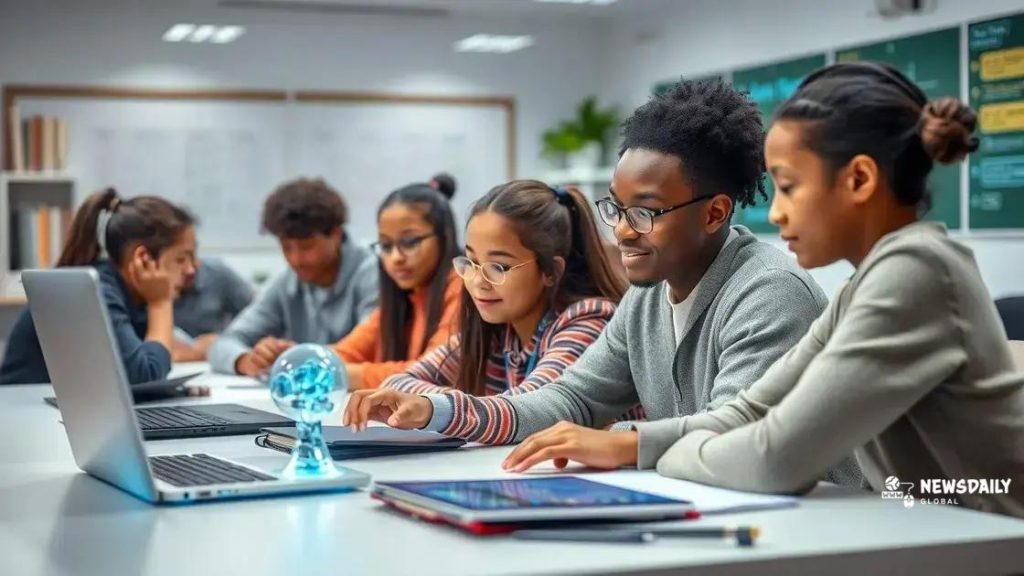AI enters the classroom: shaping the future of K-12

AI enters the classroom, transforming K-12 education by personalizing learning experiences, enhancing student engagement, and supporting teachers through innovative tools and data-driven insights.
AI enters the classroom and is set to redefine the educational landscape for K-12 students. Imagine classrooms where every student benefits from customized learning experiences tailored to their needs. Interested in how this might work? Let’s dive in!
The role of AI in personalized learning
AI plays a crucial role in personalizing learning experiences for students. It allows educators to tailor lessons to meet the unique needs of each learner. With AI’s advanced capabilities, teachers can better understand how students learn and what techniques are most effective for them.
Understanding Learning Styles
Every student has a different learning style. Some might prefer visual aids, while others excel through hands-on activities. AI can analyze student data to identify their preferred learning methods. This way, materials can be presented in ways that resonate with each learner.
Adaptive Learning Technologies
Adaptive learning platforms use AI to adjust the difficulty of tasks based on student performance. As students complete assignments, the system collects data to improve future tasks. This ensures that learners are challenged but not overwhelmed.
- Recognizes student strengths and weaknesses
- Provides instant feedback on performance
- Offers resources tailored to individual needs
- Tracks progress over time
By utilizing these technologies, teachers can cultivate a more inclusive classroom environment. It allows students to advance at their own pace, reducing frustration and increasing engagement. Moreover, AI can help identify gaps in knowledge, enabling timely interventions.
Data-Driven Insights for Educators
AI also provides valuable insights for teachers. Through data analysis, educators can see trends in student learning and adjust their teaching methods accordingly. This data can lead to more effective lesson planning and improved educational outcomes.
The integration of AI in education is not just a trend; it’s the future of personalized learning. By leveraging these innovations, we can create a more dynamic and responsive educational experience for all students, one that prioritizes their individual needs and fosters a love for learning.
How AI enhances student engagement
AI enhances student engagement by creating interactive experiences that capture attention and motivate learners. With personalized content and instant feedback, students are less likely to lose interest and more likely to stay involved in their studies.
Interactive Learning Tools
AI-powered platforms offer interactive learning activities that make lessons fun. For example, gamified learning experiences transform traditional coursework into exciting challenges. Through these tools, students can learn in a way that feels less like work and more like play.
Instant Feedback and Adaptation
One of the major benefits of AI is its ability to provide real-time feedback. Students receive immediate responses to their answers, which helps them understand concepts more deeply. This fast response time encourages them to ask questions and engage more actively.
- Promotes a growth mindset
- Encourages risk-taking in learning
- Helps identify areas for improvement quickly
- Facilitates deeper conversation between students and teachers
By incorporating AI into lessons, teachers can adapt instruction based on student input. This means that lessons can be redirected based on what excites students most, whether it’s through multimedia presentations or virtual reality experiences. Such adaptability keeps students invested in their learning journey.
Furthermore, collaborative AI tools enable students to work together on projects, even if they are not in the same location. They can share ideas in real-time, providing a sense of connection and teamwork. This interaction boosts motivation and helps students learn from one another, enhancing their engagement with the material.
With AI, the classroom is evolving into a place where students have more control over their learning. As they become more engaged, they develop a love for knowledge that can last a lifetime, making education more meaningful and enjoyable.
Teacher perspectives on AI integration

Understanding teacher perspectives on AI integration is essential for successful implementation in the classroom. Many educators recognize the benefits of using AI tools to enhance learning experiences, but they also express concerns about potential challenges.
Benefits of AI in Education
Teachers appreciate how AI can save time and foster personalized learning. With AI tools, they can automate grading and administrative tasks, allowing them to focus more on direct student engagement. This shift promotes a healthier work-life balance and provides more opportunities for individual student support.
Personalized Learning and Support
Many educators value how AI adapts to student needs. By utilizing analytics and insights from AI, teachers can tailor their instruction to meet the unique requirements of each learner. This customization allows for a more inclusive environment where all students can succeed.
- Identifies learning gaps quickly
- Offers targeted resources based on abilities
- Encourages student independence
- Enhances student-teacher communication
However, teachers are also cautious about relying too heavily on technology. There are concerns regarding the lack of human interaction and the importance of fostering emotional connections with students. Teachers stress the need to balance AI use with traditional teaching methods to maintain meaningful relationships.
Professional Development and Training
As schools begin integrating AI, the need for adequate training and professional development becomes apparent. Educators express a desire to engage in ongoing learning that equips them with the skills necessary to use AI effectively. When teachers feel confident using these tools, they can better assist their students in navigating this new learning landscape.
Many teachers believe that by elevating their understanding of AI functionalities, they can enhance their teaching strategies. Ultimately, the successful integration of AI depends heavily on teacher support, adaptability, and ongoing professional development.
Challenges of implementing AI in K-12
Implementing AI in K-12 education comes with various challenges that schools must navigate. While the benefits are clear, the path to successful integration can be complex.
Cost of Technology
One major hurdle is the cost associated with acquiring and maintaining AI technology. Schools often struggle with budget constraints, making it difficult to invest in the necessary tools and infrastructure. These costs can include software licenses, hardware upgrades, and ongoing support.
Training and Professional Development
Another significant challenge involves training educators on how to effectively utilize AI tools. Many teachers feel unprepared to implement AI in their classrooms. Providing appropriate training and ongoing professional development is crucial for enabling teachers to integrate technology confidently.
- Development of user-friendly training programs
- Access to resources and instructional guides
- Time allocated for learning and adaptation
Furthermore, resistance to change can hinder successful implementation. Some educators may be skeptical about incorporating AI into their teaching practices. Addressing these concerns and fostering a positive attitude towards technology is vital for a smooth transition.
Data Privacy and Ethics
Data privacy is another critical challenge. Schools must ensure that student information is protected and that AI tools comply with legal standards. Safeguarding sensitive data requires careful planning and the adoption of secure systems.
Additionally, educators must consider the ethical implications of using AI in the classroom. Questions arise about the potential biases in AI algorithms and their impact on student learning. Ensuring fairness and equity in AI applications is essential for all students to benefit fairly.
Ultimately, navigating these challenges requires collaboration between educators, administrators, and technology providers. By prioritizing professional development, budgeting for technology, and maintaining ethical standards, schools can overcome barriers to successful AI integration.
Future trends in AI and education
The future of AI in education is exciting and full of possibilities. As technology continues to evolve, we can expect significant shifts in how learning is delivered and experienced in classrooms.
Increased Personalization
One of the most promising trends is greater personalization in learning. AI systems will become even more sophisticated, analyzing student data to create tailor-made learning paths. This means that every student can progress at their own pace, receiving challenges suited to their unique abilities and interests.
Virtual and Augmented Reality
Another trend involves the integration of virtual and augmented reality (VR and AR) into educational settings. These technologies offer immersive learning experiences that can enhance understanding. For instance, students can explore historical sites or conduct science experiments in a virtual lab, all from their classrooms.
- Engages students through realism
- Facilitates experiential learning
- Creates scenarios that are otherwise impossible in a traditional classroom
Moreover, we may see AI-driven tutors becoming commonplace. These virtual assistants can provide extra help and resources, adapting to students’ specific needs. This support ensures that no student falls behind and allows teachers to focus on more complex instruction.
Enhanced Teacher Support
As AI tools become more prominent, they will also aid teachers in their roles. Educators will have access to data-driven insights about student performance. This information will help them make better decisions regarding curriculum adjustments and individual student interventions.
Furthermore, the automation of administrative tasks will free up time for teachers, allowing them to engage more deeply with their students. This combination of technology and human touch is likely to redefine the educational landscape.
As we look ahead, it’s clear that AI will play a crucial role in shaping the future of education. With continued advancements, we can expect classrooms that are more inclusive, interactive, and adaptable to the needs of each learner.
The advancements in AI are set to transform K-12 education in exciting ways. Schools can enhance student learning with personalized experiences and increased engagement. While there are challenges to address, such as costs and teacher training, the potential benefits far outweigh the obstacles. As we look to the future, embracing AI technology can create a more connected, efficient, and effective educational environment that supports both teachers and students.
FAQ – Frequently Asked Questions about AI in K-12 Education
How does AI personalize learning for students?
AI analyzes individual student data to tailor learning experiences, allowing each student to progress at their own pace.
What are some benefits of using AI in the classroom?
AI helps enhance student engagement, provides instant feedback, and automates administrative tasks for teachers.
What challenges do schools face when implementing AI?
Challenges include the cost of technology, the need for teacher training, and ensuring data privacy and security.
How can teachers effectively integrate AI into their teaching?
Teachers can integrate AI by participating in professional development, utilizing user-friendly tools, and aligning AI resources with curriculum goals.






